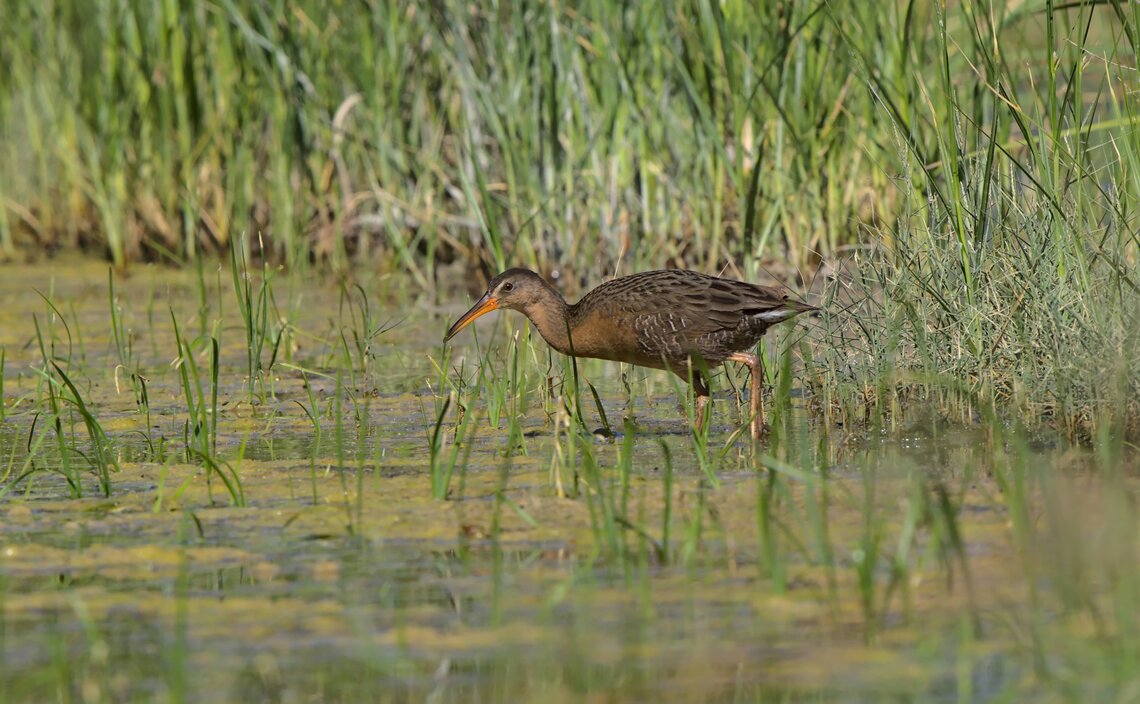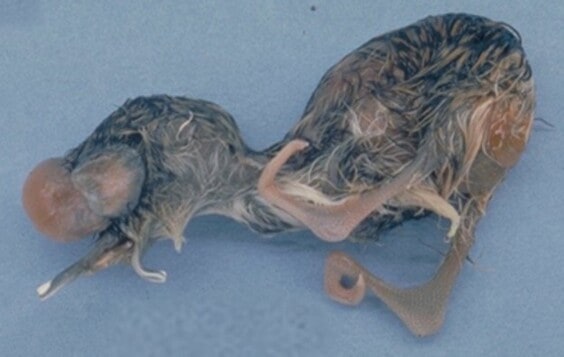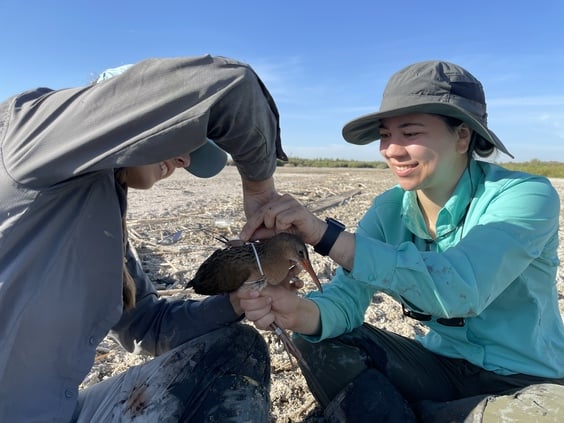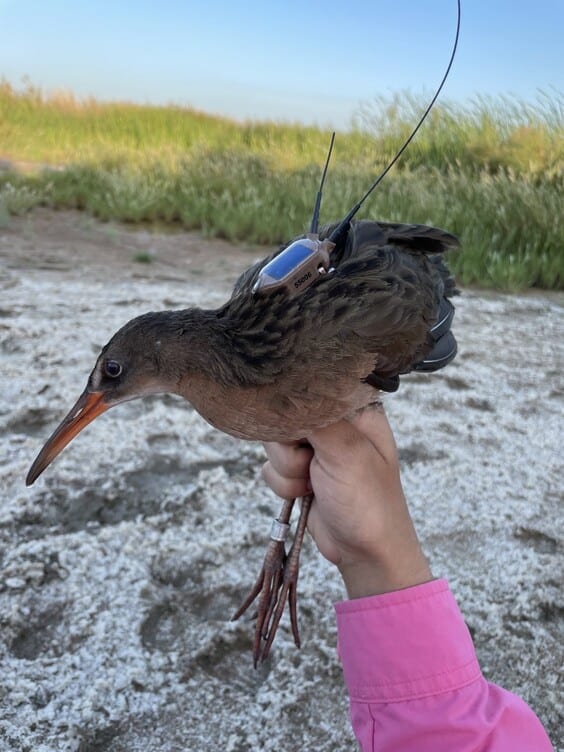
Yuma Ridgway’s Rail wandering out of the cattails – Salton Sea, California (photo by Asch McDonnell).
By Cydney Yost and Courtney Conway, U.S. Geological Survey – Idaho Cooperative Fish and Wildlife Unit and University of Idaho
Selenium is an increasingly common toxin within wetlands in North America due to its accumulation in contaminated agricultural drainage water. Selenium has been consistently found at elevated concentrations in water, sediment, and biota throughout the Western U.S. As far back as the 1930s. The threat of selenium toxicity has not been adequately mitigated despite evidence of deformities and mortalities in livestock such as chickens and cows. In the 1980s, selenium toxicity caused fetal abnormalities and mass die-offs of waterfowl and fish at Kesterson Reservoir within Kesterson National Wildlife Refuge in central California (Seiler et al. 2003). The concentrations of selenium in this wetland system were so high that this site could not be saved. The reservoir was drained, and the area delisted as a National Wildlife Refuge.

Selenium induced fetal abnormality of a Black-Necked Stilt – Kesterson Reservoir, California (photo by Seiler et al. 2003).
The catastrophe at Kesterson increased awareness regarding the paucity of current knowledge on the effects of selenium accumulation at irrigation sites, National Wildlife Refuges, and other wetlands. Recognizing this need, the Department of the Interior formed the National Irrigation Water Quality Program in 1986 to address selenium contamination concerns. A major area of interest for this new program was the Salton Sea in southern California – a highly saline, freshwater lake fed by a large amount of irrigation runoff.
Several agencies within the Lower Colorado River Basin (including the Sonny Bono Salton Sea National Wildlife Refuge) use Colorado River water to manage marshes explicitly for the benefit of endangered species that are at a high risk of selenium toxicity. The Yuma Ridgway’s Rail is one such species native to wetlands throughout the Lower Colorado River Basin.
Yuma Ridgway’s Rails are rare – an extensive annual survey effort throughout their range has detected fewer than 900 rails in the U.S. during each of the previous 5 years. Furthermore, this species is notoriously difficult to study due to its secretive behavior and the dense vegetation and inhospitable conditions that it inhabits.
Wetlands within the rail’s small geographic range are fragmented and embedded in a landscape largely dominated by desert, human development, and intensive agriculture – a landscape that is now almost entirely inhospitable to rails.

University of Idaho researchers attach a GPS transmitter to an adult Yuma Ridgway’s Rail – Salton Sea, California (photo by Cydney Yost).
Marshes have emerged in areas along irrigation drains surrounding the shoreline of the Salton Sea and other agricultural areas. Although these unmanaged marshes increase the amount of habitat available to the rails, they may ultimately serve as an ecological trap, luring rails away from managed marshes with lower selenium concentrations. The selenium concentrations in irrigation drain water at some unmanaged marshes used by the Yuma Ridgway’s Rail exceed EPA standards of water quality and prior studies have reported elevated selenium levels in rail tissues and in the prey that they rely on. The thresholds at which selenium begins to pose a threat to rail survival and reproductive success is not yet clear. The potential for selenium toxicity is both species- and habitat-specific; influenced by several factors such as dietary exposure and rate of transfer through the food web. To address this gap in knowledge, we began working with several partners to document the level of selenium concentrations that Yuma Ridgway’s Rails were being exposed to at the Salton Sea. Moreover, we wanted to test whether selenium concentrations differed between managed and unmanaged marshes the Salton Sea.
We began capturing and tagging Yuma Ridgway’s Rails in 2020. We attached GPS transmitters, which are perfectly suited for working with this rare bird because they allow us to overcome the challenges of documenting movements in difficult to access locations. We use the GPS data to locate nests of breeding pairs and to track movements of rails between managed and unmanaged marshes. Our team then worked to analyze the data, taking samples to measure selenium concentrations in rail blood, tissue, and eggs, as well as those of their prey.

Adult Yuma Ridgway’s Rail equipped with a GPS transmitter – Salton Sea, California (photo by Cydney Yost).
Even though the research project is still ongoing, samples collected as recently as 2020 show that selenium concentrations vary widely between rails living in managed and unmanaged marshes. Most rail prey (83%) collected from unmanaged marshes had selenium concentrations above 4 ppm, suggesting rails in unmanaged marshes face greater dietary exposure risk than rails in managed marshes. If high selenium concentrations persist, rail survival and reproductive success may be reduced and population numbers may continue to plummet.
Selenium toxicity is not just a threat at the Salton Sea, and the Yuma Ridgway’s Rail is far from the only species threatened. Yuma Ridgway’s Rails are exposed to selenium throughout the Lower Colorado River Basin. The results of this work will help guide conservation efforts both locally and throughout the western U.S. and Mexico. Continuing to tag rails will allow us to record the frequency of movements between marsh types throughout California, Arizona, Nevada, and Mexico. As remaining marsh habitat is diminished, it is vital to understand how the water quality in managed and unmanaged marshes along the Lower Colorado River affects the reproductive success of this endangered species. But it’s up to us. The Yuma Ridgway’s Rail is an important indicator species of wetland quality and is not only dependent on marshes but is also dependent on our ability to ensure that the quality of those marshes is not compromised.
This research would not be possible without the funding and support of our partners at Sonny Bono Salton Sea National Wildlife Refuge, U.S. Fish and Wildlife Service, and Bureau of Reclamation.


 English
English  Español
Español